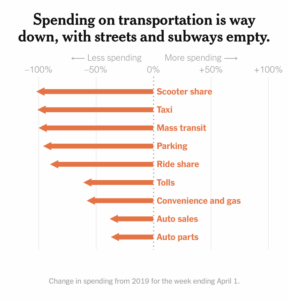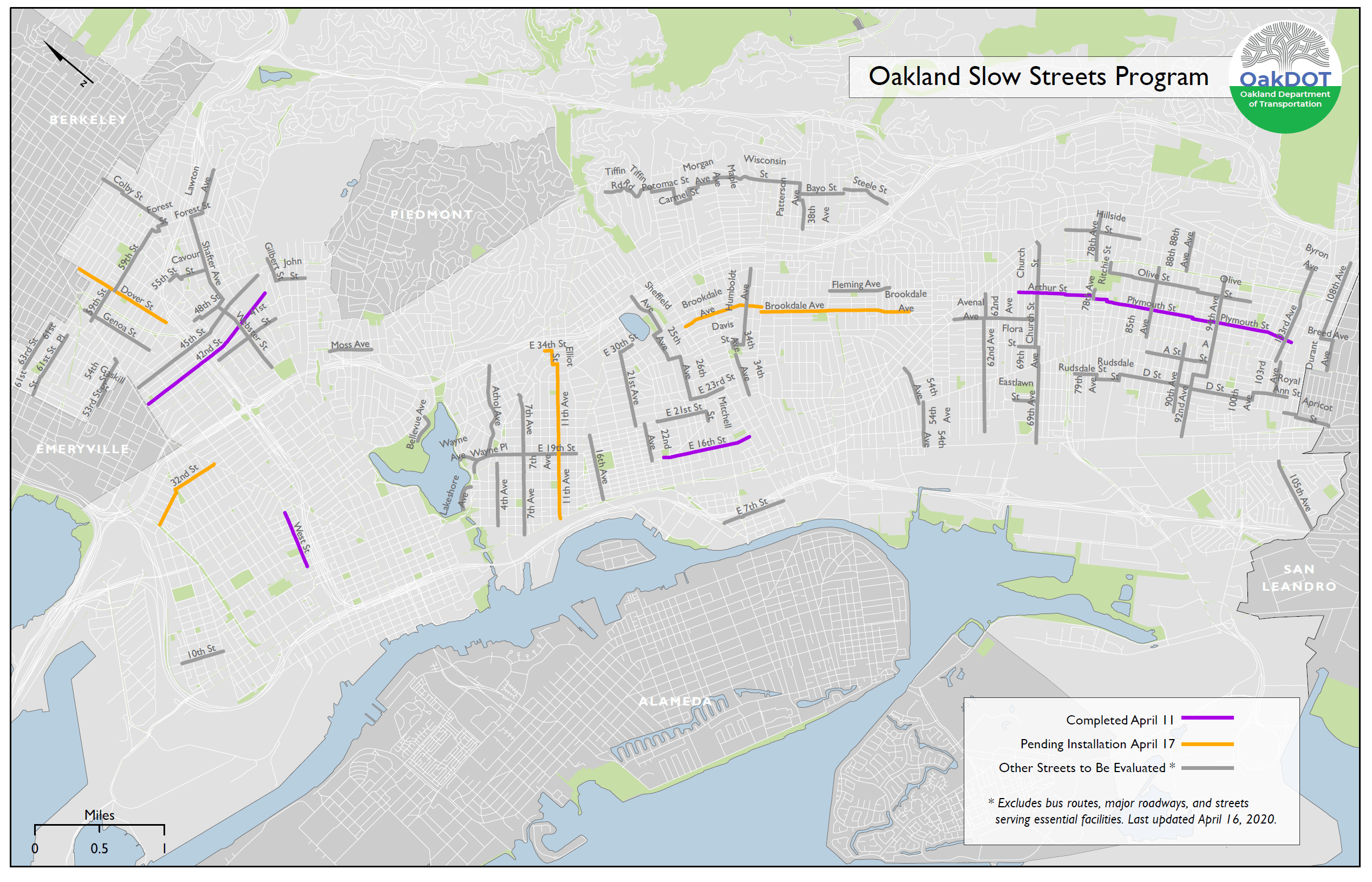Status Update, April 23: COVID-19 Crisis Impact on Transit & Shared Mobility
20 minutes Date Launched/Enacted: Apr 24, 2020 Date Published: April 24, 2020

Brief Summary
- This is the second status update on impacts and responses to the COVID-19 pandemic. This update is organized by mode and explores the trends that emerged through April, when most stay-at-home orders were in effect and cities established more comprehensive plans to address the crisis.
- Ridership on public transit has continued to decline due to commuters working from home, restrictions on recreational travel, and cuts to service.
- In the micromobility sector, e-scooter and moped operators have established programs allowing free transportation for frontline workers, however the future of e-scooter companies is overall uncertain.
- Most AV testing has been suspended, but some vehicles have been used to help facilitate the transportation of medical supplies, and experts predict an uptick in interest in AVs for driverless deliveries.
Introduction
This is the second installment of SUMC’s ongoing effort to explore how cities and transportation sectors are impacted by the novel COVID-19 coronavirus. The first status update, published April 8th, 2020, highlighted some of the ways public agencies and shared mobility operators responded to the initial weeks of the outbreak. This second update is organized by mode and explores the trends that emerged through the month of April, when most stay-at-home orders were in effect and cities established more comprehensive plans to address the crisis.
SUMC will continue to track emerging patterns and responses as the COVID-19 crisis unfolds. Subsequent status updates on the coronavirus’s impact on transit and shared mobility will be published as new information is shared.
Public Transit
Due to concerns about safety aboard crowded public transit vehicles, greater numbers of commuters working from home, and state- and city-level restrictions on recreational travel, ridership on public transit has continued to decline in recent weeks. According to a New York Times assessment of the impact COVID-19 has had on the way Americans spend their money, spending on transportation has fallen significantly, with spending on public transit modes down precipitously over 2019 numbers. This holds true for private vehicle travel as well; according to data published by StreetLight Data and Cuebiq, driving is down in all major markets across the US.

Source: NYTimes; https://www.nytimes.com/interactive/2020/04/11/business/economy/coronavirus-us-economy-spending.html?referringSource=articleShare
In the immediate days and weeks of the outbreak in March, one of the ways agencies tried to limit the spread of the virus and protect their employees was by cutting service. These cuts have continued through April. For example, San Francisco’s Muni public transit system has limited operations to just 17 of the agency’s total 83 rail and bus lines.
Despite the reductions to service and protective gear issued to transit employees, there has been growing concern in recent weeks about workers’ safety and health. For example:
- Nearly 100 US transit workers have died of Covid-19 amid lack of basic protections; (The Guardian, April 20)
- 41 Transit Workers Dead in New York: Crisis Takes Staggering Toll on Subways (The New York Times, April 8); and
- Hit Hard by Covid-19, Transit Workers Call for Shutdowns (CityLab, April 13).
One of the promising trends relating to public transit in the latter part of April has been that many agencies are taking advantage of the growing number of COVID-19 resources and response tools being published. Some of these helpful resources include:
- FTA: New Web Content with Guidance Related to COVID-19, April 23
- FTA Safety Advisory 20-01: Recommended Actions to Reduce the Risk of Coronavirus Disease 2019 (Covid-19) Among Transit Employees and Passengers, April 14
- NATCO COVID19 response center & city updates tracker, updated regularly
- NUMO, Transportation for America: Recovery, Next Steps & Long-Term Policy Presentation slides, April 16
- Smart Growth America, Transportation for America: Learning from the 2009 Recovery Act, April 2020
- World Economic Forum: New Mobility COVID-19 Taskforce Insight Report, April 7
- National League of Cities: COVID action tracker for cities, updated regularly
- Smart Cities Drive: tracker exploring the impact of coronavirus on US cities, updated daily
In addition to more tools being made available to public transit agencies to guide responses to the crisis, estimates continue to be updated assessing how the pandemic may impact cities and agencies. Looking ahead, however, timelines for the resolution of the crisis remain unclear, and cities and states are uncertain when ridership and service will return to its pre-pandemic levels. As a result, these estimates will continue to evolve in the coming weeks. Nevertheless, there are significant concerns already regarding the lasting effect of the lost revenue. For example:
- Transit Center released updated estimates of the financial impact of COVID-19 on US transit agencies, placing the annual cost at $26-$40 billion (initial estimates posted March 20th, updated April 7th); and
- A survey conducted by the U.S. Conference of Mayors and the National League of Cities found that 88% of respondents anticipate “painful reductions in revenue this year” as a result of the pandemic, with one respondent saying that cities will be left “hanging by a thread” (Smart Cities Drive, April 15).
Increased attention has also been paid recently to how the crisis can be disproportionally challenging for people with disabilities to navigate. For instance:
- The reduced public service and routes caused by COVID-19 can be particularly difficult for people with limited mobility to overcome (Streetsblog California, April 21);
- Although rear-door boarding policies are intended to protect public transit employees by reducing exposure to potentially sick passengers, the policies tend to leave some disabled riders struggling (Streetsblog Chicago, April 20); and
- Programs for seniors like Meals on Wheels are struggling to contend with both the increased number of seniors self-isolating at home and a decrease in volunteers willing to help (AARP, March 18).
More broadly, there are growing equity concerns related to COVID-19, and in particular, the racial disparity in the number of cases and deaths caused by the virus around the country. In Chicago, for example, although African Americans comprise of 29% of the city’s total population, 70% of the 86 residents that had passed away due to the coronavirus by April 4th were black. In response, the Active Transportation Alliance, SUMC, and a group of other advocacy and civic organizations collaborated in a letter urging the governing boards of the region’s transit agencies to prioritize racial equity and include riders and residents in the decision-making process for COVID-19 response and recovery.
Micromobility
When it comes to micromobility modes like bikesharing and scooter sharing, we have observed both optimistic and less optimistic signs from the industry in the month of April 2020. From an optimistic perspective, several e-scooter and moped operators have established temporary programs to provide free transportation for workers on the front line fighting COVID-19, including Lyft, Spin and Revel, showcasing a willingness to be civic-minded businesses at a critical time. In addition, a growing number of cities are finding ways to prioritize micromobility modes in a promising new manner. As mentioned in the first status update, leaders in Bogota, Columbia received global praise for expanding the city’s micromobility infrastructure by turning car lanes into protected bike and scooter lanes. Since that time, more cities have followed in their wake:
- New Zealand First Country To Fund Pop-Up Bike Lanes, Widened Sidewalks During Lockdown
- Pop-up bike lanes help with coronavirus physical distancing in Germany
- Car-Free ‘Slow Streets’ Program launched by San Francisco MTA to help with social distancing, April 21
- City of Oakland closed 74 miles of road lanes to support safe physical activity and social distancing.
Less optimistically, there is a growing concern about the future of e-scooters, particularly as the crisis continues to wreak havoc on the previously-anticipated boom in ridership that warmer spring weather traditionally brings. Companies Bird and Lime have suspended service globally (with some exceptions in the Eastern Hemisphere), and Voi, a start-up scooter company in Europe, furloughed most of its staff. Fundraising for these companies has also become more difficult, with Lime’s valuation predicted to fall as much as 80%. As a result of these trends, the fate of e-scooters going forward appears uncertain, with some experts suggesting that cities may need to step in to help them survive.
Taxis, TNCs and Carsharing
For TNCs and charsharing, little has changed in recent weeks. Uber expanded its sick leave policy to be more inclusive to drivers needing paid time off during the crisis, and it also launched a “thank you for not riding” campaign. Most companies continue to issue updates regarding the safety precautions they are taking to protect employees and customers.
In addition to its Uber Direct program in select cities around the globe to deliver groceries and medicine from retailers, Uber also launched Uber Connect in major markets in the US this week, which customers can use to send same-day packages to friends and family nearby. Despite these efforts, however, use of TNCs remains low, and Uber withdrew its previously released guidance for bookings and revenue in 2020, due to the financial impact of the virus.
Use of taxis is also low. On March 25th, New York City’s Metropolitan Taxicab Board of Trade said that taxi rides had decreased by 91% compared to three weeks prior.
Autonomous Vehicles (AVs)
Although most AVs testing passenger routes were halted at the outset of the outbreak, some AVs have been used to help transport COVID-19 test to medical centers, or to transport medical supplies around treatment facilities. Some experts are also predicting an uptick in interest in AVs following the crisis, particularly for driverless deliveries.
Paratransit
Some transit agencies have taken additional steps to meet the specified needs of their paratransit-eligible customers, many of whom may be at a higher risk for the virus:

Credit: TriMet
- TriMet in the Portland, OR area has established a free grocery pickup and delivery for service for its paratransit-eligible customers to encourage physical distancing and make it possible to get essential items from grocery stores and food banks; and
- Valley Metro Paratransit in Phoenix, AZ has launched a delivery service for meals, pharmacy, and groceries for its paratransit-certified customers, and it began to offer single-rider trips to reduce exposure for riders and drivers.
Looking Ahead
Despite the still uncertain timelines for states and cities to return to “business as usual” following the COVID-19 pandemic, some in the public transit and shared mobility sectors are encouraging planners to look ahead now. Much published thus far encourages leveraging the current upheaval by shifting away from car-centric mentalities to more sustainable, equitable systems:
- Let’s plan for the coming ‘new normal’ (CommonWealth Magazine, April 12)
- COVID-19 could forever change how we travel—for better or worse (Fast & Company, April 13)
- A ‘different world’ awaits transit on the other side of coronavirus (Smart Cities Drive, April 13)
